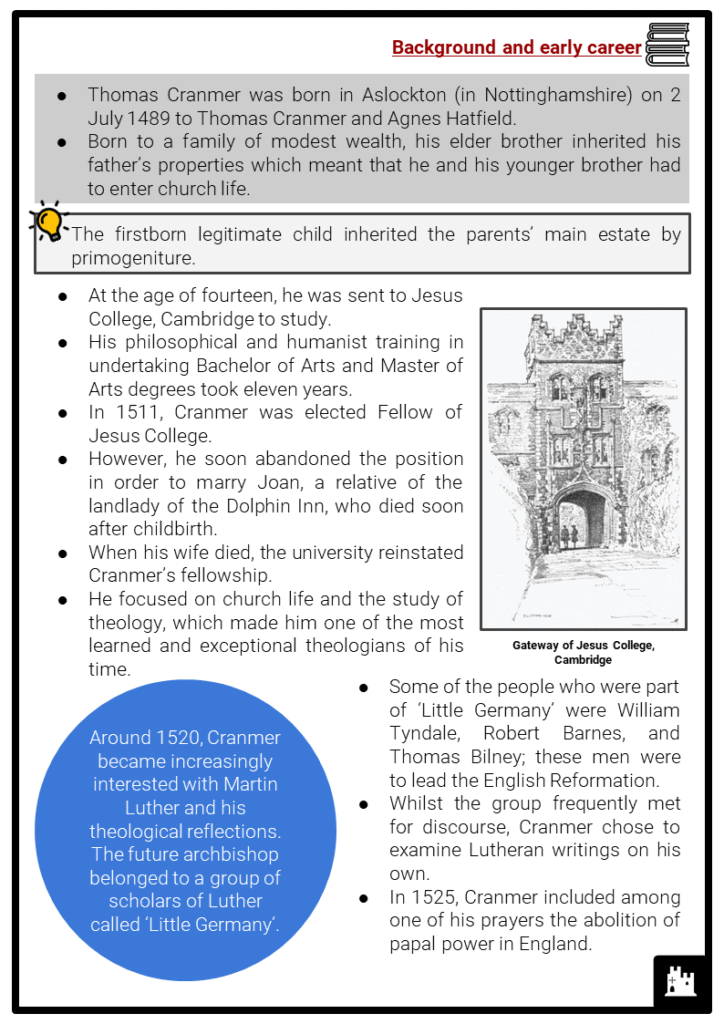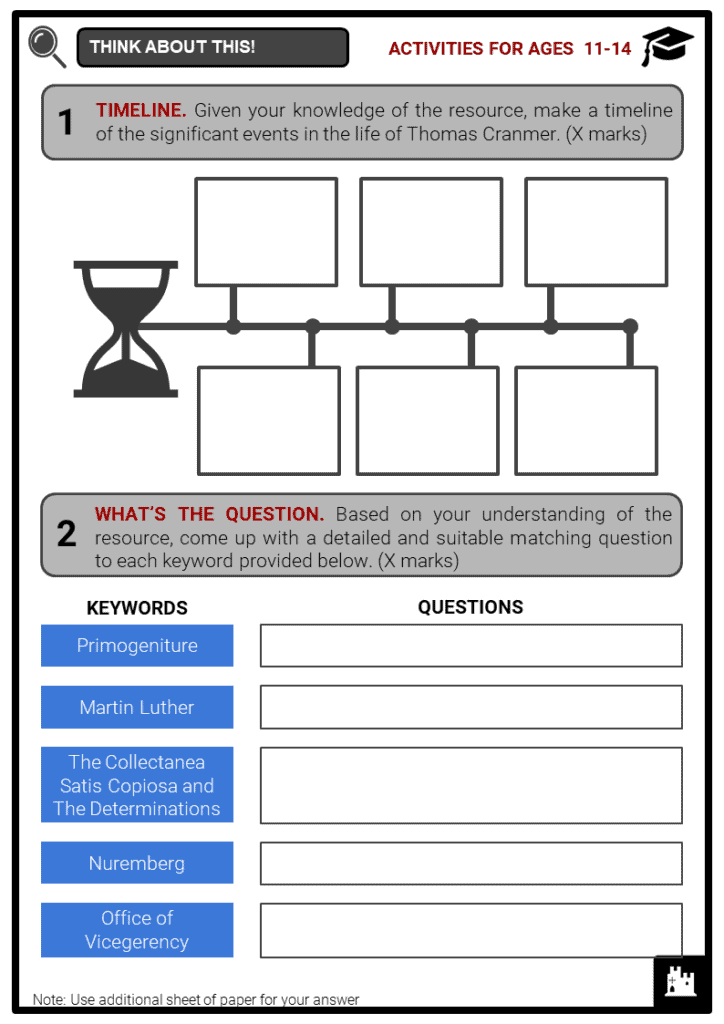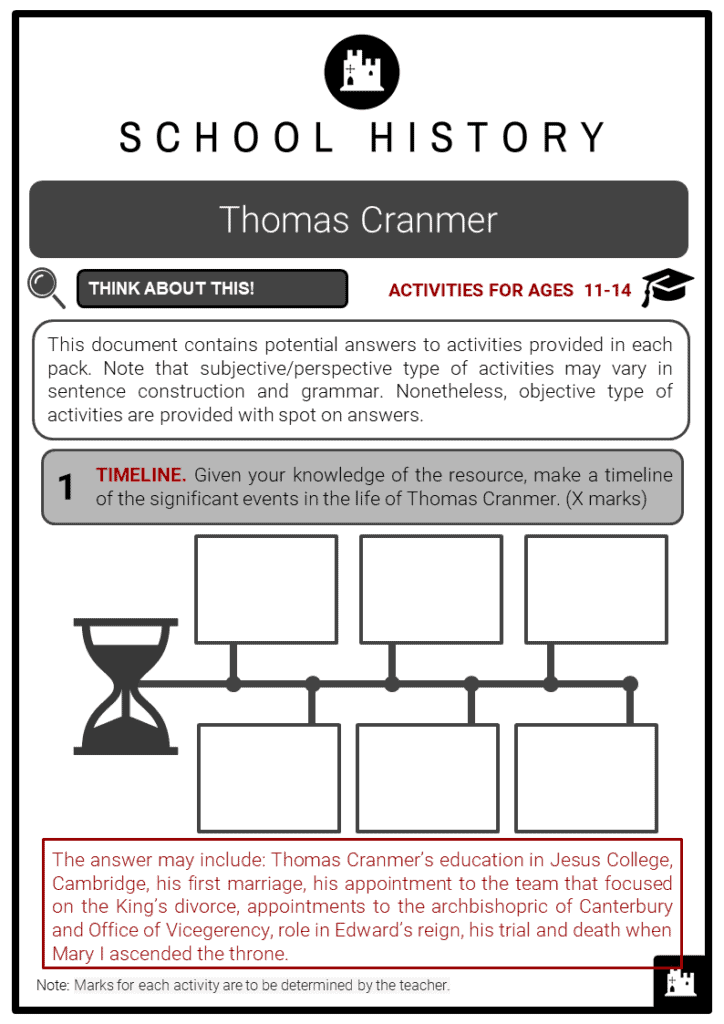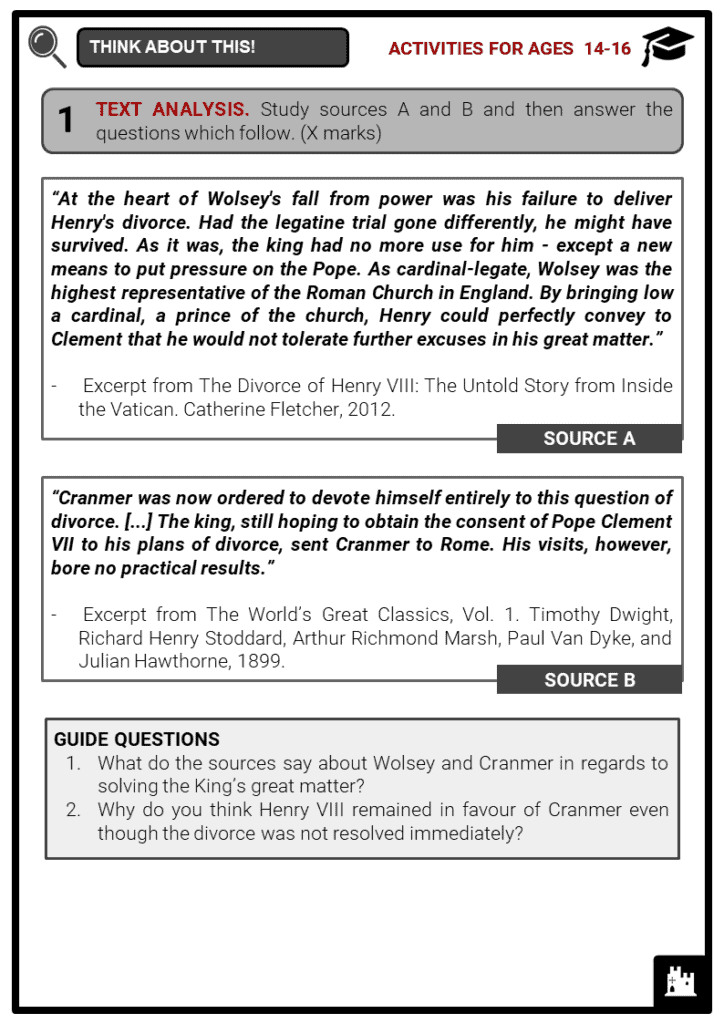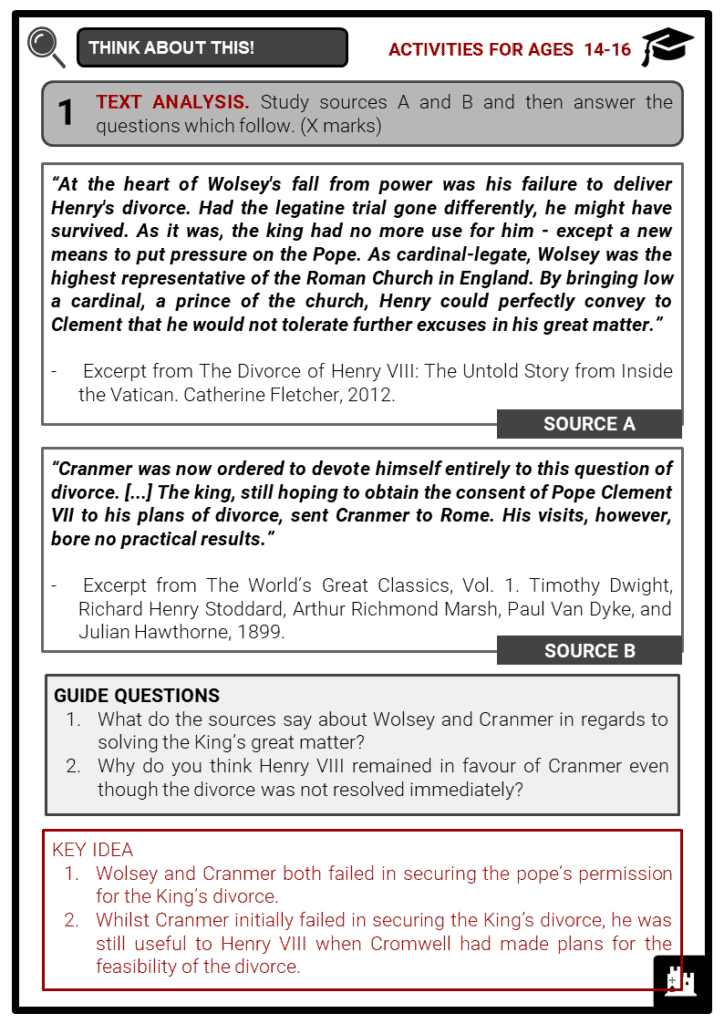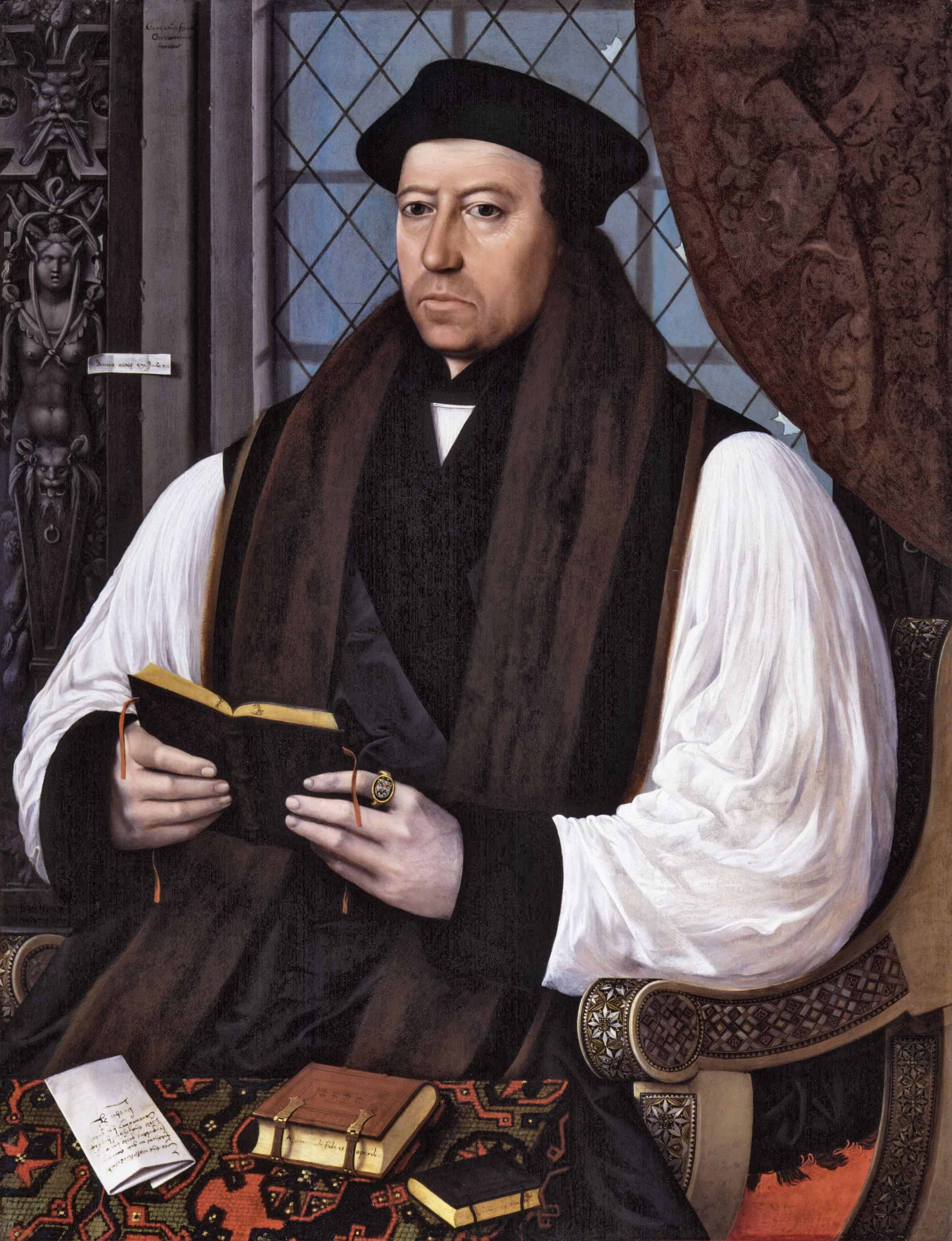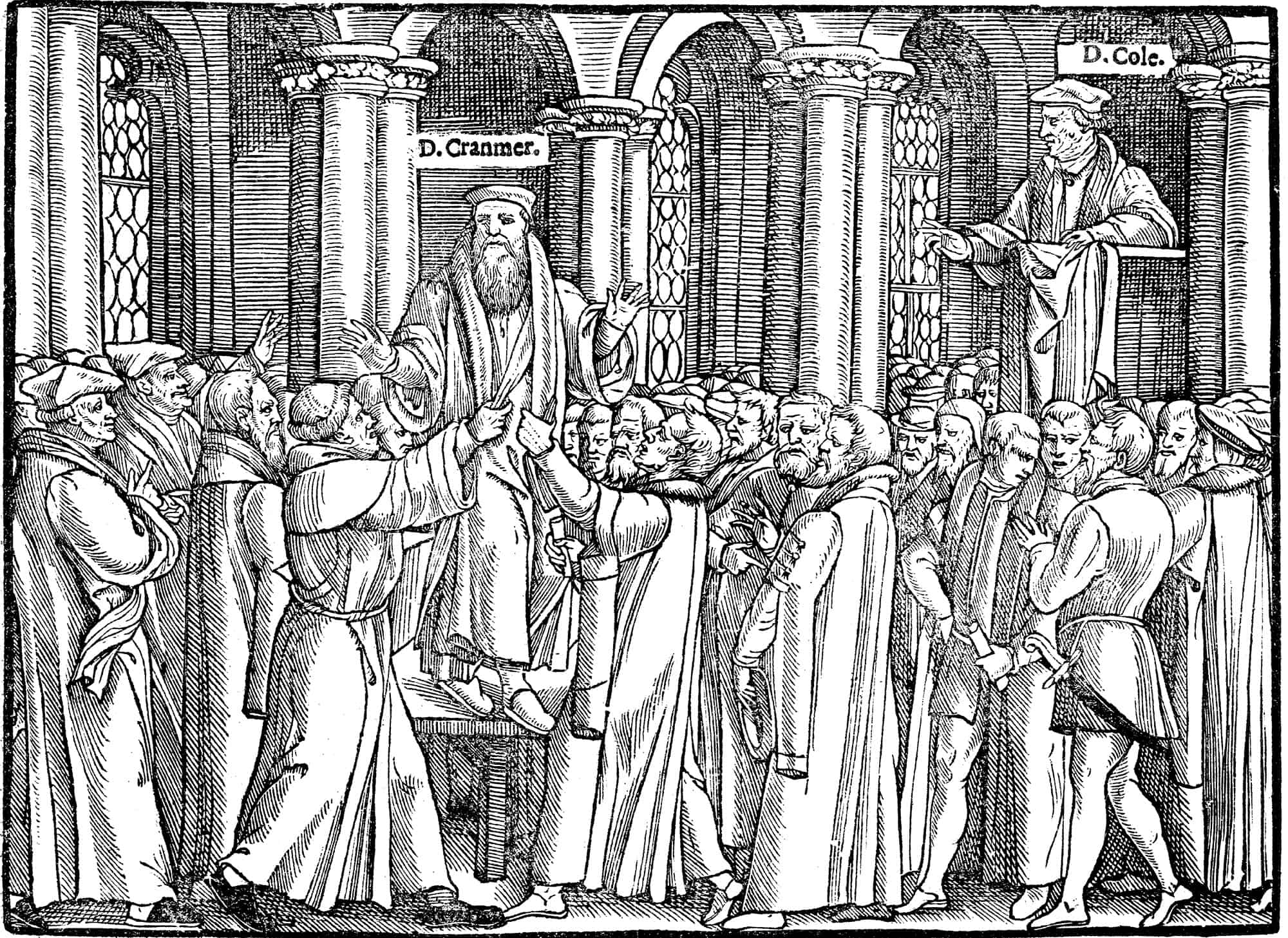Download Thomas Cranmer Worksheets
Do you want to save dozens of hours in time? Get your evenings and weekends back? Be able to teach Thomas Cranmer to your students?
Our worksheet bundle includes a fact file and printable worksheets and student activities. Perfect for both the classroom and homeschooling!
Table of Contents
Add a header to begin generating the table of contents
Summary
- Background and early career
- Entry to the King’s service
- Appointments to the Archbishopric of Canterbury
- and Office of the Vicegerency
- Accomplishments under Edward VI
- Trial and death of Thomas Cranmer
Key Facts And Information
Let’s know more about Thomas Cranmer!
- Thomas Cranmer was destined for church life, although he abandoned it briefly for his first marriage. His interest in Martin Luther’s teaching and the Reformation grew significantly during his fellowship at Jesus College, Cambridge. His involvement with the ‘great matter’ of Henry VIII of England propelled him to be appointed to the Archbishopric of Canterbury. He had served the Crown loyally, first Henry VIII and then Edward VI, and did as he was told. His liturgical work that leaned towards reformed thinking were completed under Edward VI.
- The reign of the Catholic Mary I brought Cranmer’s demise when he was convicted of treason and heresy and died ever faithful to royal supremacy.
Background and early career
- Thomas Cranmer was born in Aslockton (in Nottinghamshire) on 2 July 1489 to Thomas Cranmer and Agnes Hatfield.
- Born to a family of modest wealth, his elder brother inherited his father’s properties which meant that he and his younger brother had to enter church life.
- The firstborn legitimate child inherited the parents’ main estate by primogeniture.
- At the age of fourteen, he was sent to Jesus College, Cambridge to study.
- His philosophical and humanist training in undertaking Bachelor of Arts and Master of Arts degrees took eleven years.
- In 1511, Cranmer was elected Fellow of Jesus College.
- However, he soon abandoned the position in order to marry Joan, a relative of the landlady of the Dolphin Inn, who died soon after childbirth.
- When his wife died, the university reinstated Cranmer’s fellowship.
- He focused on church life and the study of theology, which made him one of the most learned and exceptional theologians of his time.
- Around 1520, Cranmer became increasingly interested with Martin Luther and his theological reflections. The future archbishop belonged to a group of scholars of Luther called ‘Little Germany’.
- Some of the people who were part of ‘Little Germany’ were William Tyndale, Robert Barnes, and Thomas Bilney; these men were to lead the English Reformation.
- Whilst the group frequently met for discourse, Cranmer chose to examine Lutheran writings on his own.
- In 1525, Cranmer included among one of his prayers the abolition of papal power in England.
Entry to the King’s service
- Cranmer’s prominence can be traced back to his proficiency in closely studying the Scriptures and explaining arguments on the basis of this independent study.
- Cranmer took the holy orders and became a Doctor of Divinity in 1526.
- He was both a lecturer in divinity at Jesus College and a public examiner of divinity to the university.
- In 1529, when England was afflicted by the sweating sickness, Cranmer abandoned Cambridge with two pupils who were related to him, and settled at Waltham (in Essex).
- Whilst at Waltham, Cranmer met the King’s chief councillors, Edward Foxe and Stephen Gardiner; the King’s ‘great matter’ was discussed.
- At that time, Henry VIII was seeking the annulment of his marriage to Catherine of Aragon.
- It was Cranmer who suggested to the councillors that the universities of Europe should be consulted on the legality of Henry VIII’s marriage to Catherine, so avoiding an appeal to Rome for its annulment.
- The King welcomed the idea and chose Cranmer as a member of the team in charge of its execution.
- The team was commissioned to write a propaganda treatise in the King’s interest, supported with arguments from Scripture.
- The Collectanea Satis Copiosa (“The Sufficiently Abundant Collections”) and The Determinations were produced by the team in Rome, under Edward Foxe.
- These documents supported the notion that Henry VIII had the supreme jurisdiction within his realm.
- It was believed that Cranmer and Henry had made a pact: if Cranmer helped him with the divorce, the King would appoint him archbishop of Canterbury.
- Cranmer defended these arguments before the universities of Oxford and Cambridge and was delegated to Rome in 1530 to discuss the matter, where the Pope welcomed him.
- He was appointed grand penitentiary of England but the great matter was left undecided.
Appointments to the Archbishopric of Canterbury and Office of the Vicegerency
- As an ambassador to the Holy Roman Emperor Charles V, Cranmer was sent to Germany to arrange an alliance with the Lutheran princes in 1532.
- It was during this time when Cranmer saw the effects of Reformation in Nuremberg.
- Despite his celibacy vow, he married Margaret, the niece of the German Lutheran theologian Andreas Osiander, an action that was to prove awkward.
- Margaret bore him a daughter (Margaret) in 1532 and a son (Thomas) when their marriage became open during the reign of Edward VI.
- To his own surprise, he was appointed Archbishop of Canterbury following the death of Archbishop William Warham.
- This appointment was secured by Anne Boleyn and her family and surprised the people in London since he only had minor positions in the Church.
- Cranmer was forced to hide his married status because of the archbishop appointment.
- Thomas Cromwell, the King’s chief adviser had a plan for the granting of the King’s divorce and had drafted the Act of Restraints of Appeals in 1533, which supported the King’s supremacy.
- In March 1533, Cranmer was consecrated as a bishop and instituted in Canterbury.
- Thomas Cranmer was the first Protestant Archbishop in England.
- As was expected, Cranmer at once declared Henry’s marriage to Catherine null and void and confirmed as valid the King’s marriage to Anne Boleyn, who was already pregnant at that time.
- During Anne Boleyn’s coronation, he anointed the Queen and delivered to her the sceptre and rod.
- When Anne Boleyn’s daughter, the future Queen Elizabeth I was born, Cranmer baptised her and served as her godfather.
- By 1534, it was clear that Cranmer had completely broken with Rome when he replaced the old guard in his ecclesiastical province with men who followed the reformed thinking and supported the reformers in religious disputes.
- The conservative bishops within his province objected to Cranmer’s appointment.
- In fact, Cranmer had to avoid locations where his authority was likely to be challenged.
- The office of the vicegerent was then headed by Thomas Cromwell to create a clear structure to the royal supremacy.
- The archbishop had to work with Cromwell in regards to the King’s spiritual jurisdiction.
- The political tasks were left to Cromwell.
- Anne Boleyn’s last confession to Cranmer remains unknown.
- In 1536, whilst initially he doubted Anne Boleyn’s guilt, Cranmer accepted the Queen’s confession and annulled her marriage with the King.
- He publicly mourned the death of Anne when she was executed in the tower.
- Still in pursuit of a male heir that Anne had not provided, Henry VIII was already interested in Jane Seymour.
- The office of the vicegerency had kept the pace of the English Reformation under control.
- The Ten Articles were accepted by Cranmer, Cromwell, and the convocation; it was an attempt to define the Church under the reign of Henry VIII.
- Whilst it both pleased and annoyed opposing sides of creed, it provided balance between the conservatives and the reformers.
- As archbishop he did much to make possible the reading of the Bible in English and opposed the reaction that led to the Six Articles in 1539; these reasserted most points of the Catholic doctrine, including celibacy of the clergy and transubstantiation.
- When the Pilgrimage of Grace broke out in late 1536, Cranmer kept a low profile since he and Cromwell were the primary targets of the protesters.
- Cranmer officiated the marriage ceremony between Henry VIII and Anne of Cleves in 1540: a marriage that was arranged by Cromwell to bring back possible alliance with Schmalkaldic League.
- When Cromwell fell from power due to the failed marriage, Cranmer defended Cromwell’s past work by writing to the King privately.
- Cromwell’s death left the burden of leading the vicegerency to Cranmer which made the archbishop cling to the King’s authority.
- Thomas Cranmer believed in obedience to the divine right of kings and princes, as taught by the Scripture.
- Cranmer assisted in the divorce of Anne of Cleves from the King, and in 1542, he took an essential part in the proceedings that led to the execution of the King’s fifth wife, Katherine Howard.
- He did as he was told when it came to the politics of the King’s marriage, even when he did not share the same views as the King.
- Whilst Cranmer’s enemies had plotted to convict him of heresy, they were unsuccessful; his loyalty to the Crown had saved him from the King’s disfavour.
- On 28 January 1547, when Henry VIII lay dying, Cranmer anointed him using the reformed statement of faith and held the King’s hand.
- Cranmer grieved the King’s death by growing a beard; the beard also marked his rejection of the old faith.
Accomplishments under Edward VI
- The ascension of Protestant-raised Edward VI in 1547 put Cranmer in a special council that was to advise and guide the child king.
- The English Reformation was solidified under the protectorate of Edward Seymour and John Dudley which meant that Cranmer took the chief role in the doctrine labours.
- It was under Edward VI that Cranmer was truly able to put into practice his beliefs and completed the liturgical work that he had begun during Henry’s reign.
- Cranmer’s accomplishments during the Edwardian Reformation:
- Book of Homilies that outlined correct doctrine was published in 1548.
- Translation of the catechism of Justus Jonas was released in 1548.
- Clerical celibacy was abolished.
- The Order of the Communion, a vernacular devotion for the people's Communion at Mass came about in 1548.
- The Book of Common Prayer was used under the Act of Uniformity 1549.
- Defence of the True and Catholic Doctrine of the Sacrament appeared in 1550.
- The Form and Manner for ordaining bishops, priests, and deacons was released in 1550.
- The revised Book of Common Prayer was released in 1552.
- The Book of Common Prayer was to survive Mary’s reign.
Trial and death of Thomas Cranmer
- In 1553, when Edward VI was certain that his health showed no progress, he devised the ascension of his Protestant cousin, Lady Jane Grey, disregarding the acts of succession which put Mary and Elizabeth next in line.
- Whilst Cranmer was not in favour of Edward’s will, he ultimately supported the King’s decision.
- Cranmer performed the last rites for Edward VI.
- The nine-day reign of Lady Jane Grey came to an end when the Catholic Mary’s right to the Crown was supported by the populace of England.
- Cranmer advised the reformers to flee England to save themselves from conviction whilst he decided to stay.
- Conservative clergy replaced the reformed bishops as Mary I attempted to reverse the reformation in England.
- Cranmer defended his reformed faith against the accusation that he authorised the English mass in the Canterbury cathedral.
- On 14 September 1553, as a consequence, he was sent to the Tower of London, where the other rebels and reformers were brought.
- He was tried by an ecclesiastical court which convicted him of heresy and treason, denied him of his archbishop position, and turned him over to the civil authorities.
- Whilst he repeatedly recanted most of his Protestant views, acknowledging papal supremacy, at the last moment Cranmer renounced these recantations.
- Cranmer was asked to make his final recantation, which Queen Mary had planned to circulate to discourage reformers.
- In his last speech, Cranmer states:
- First, it is an heavy case to see that many folks be so much doted upon the love of this false world, and so careful for it, that for the love of God, or the love of the world to come, they seem to care very little or nothing therefore. This shall be my first exhortation: That you set not overmuch by this false glosing world, but upon God and the world to come. And learn to know what this lesson meaneth, which St John teacheth, that the love of this world is hatred against God […] First, I believe in God the Father Almighty, Maker of heaven and earth, &c. and every article of the Catholic faith, every word and sentence taught by our Saviour Christ, his Apostles and Prophets, in the Old and New Testament. And now I come to the great thing that troubleth my conscience more than any other thing that ever I said or did in my life: and that is, the setting abroad of writings contrary to the truth. Which here now I renounce and refuse, as things written with my hand contrary to the truth which I thought in my heart, and writ for fear of death, and to save my life, if it might be: and that is, all such bills, which I have written or signed with mine own hand, since my degradation; wherein I have written many things untrue. And forasmuch as my hand offended in writing contrary to my heart, therefore my hand shall first be punished. For if I may come to the fire, it shall be first burned. And as for the Pope, I refuse him, as Christ’s enemy and antichrist, with all his false doctrine.
- When burned at the stake in Oxford, on 21 March 1556, he held out the offending right hand that had signed the false recantations, that it might be consumed first.
- His last courageous act had restored the faith of the surviving reformers.
- An obscure man, filled with scholarly uncertainties in a changing religious age, Cranmer found security only in the complete supremacy of the Crown over the Church.
Image sources:
[1.] https://upload.wikimedia.org/wikipedia/commons/2/2b/Thomas_Cranmer_by_Gerlach_Flicke.jpg
[2.] https://upload.wikimedia.org/wikipedia/commons/a/a3/Trial_of_Thomas_Cranmer.jpg


